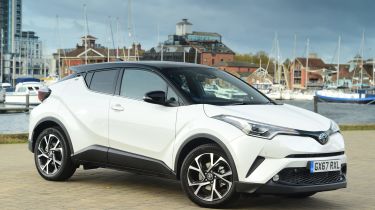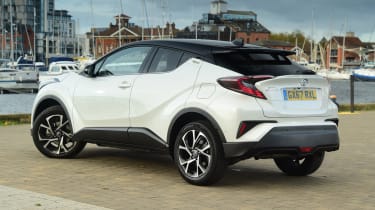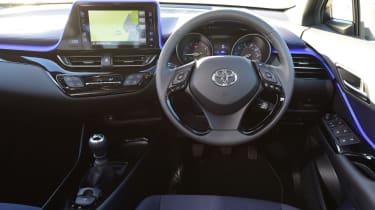Used Toyota C-HR review
A full used buyer’s guide on the Toyota C-HR covering the C-HR Mk1 (2017-date)
Toyota is a fascinating company with a fascinating history. Founded in 1937, it was one of the first Japanese car makers to sell its wares in the UK, arriving here in 1965. Toyota has sold more than three million cars here since then, and started building models in Derbyshire in 1992.
Now one of the world’s biggest car makers, vying for supremacy with the Volkswagen Group, Toyota has built a massive following largely because of its peerless reputation for exceptional reliability, and therefore terrific ease of ownership. Stand-out design and driving pleasure have been less evident until recently, but these are no longer forgotten; and the C-HR is the evidence of that, with its distinctive design and engaging dynamics.
Models covered
- Toyota C-HR (2017-date) - crossover has sharp looks, a decent cabin and good levels of kit, backed up by Toyota’s reputation for reliability.
History
The C-HR was unveiled at the Geneva Motor Show in spring 2016, but the first cars weren’t delivered in the UK until January 2017. Buyers could choose between a 114bhp turbocharged 1.2-litre petrol engine or a 120bhp 1.8-litre Hybrid. While the hybrid came only with front-wheel drive and a CVT automatic transmission, the 1.2T was offered in manual or automatic forms, the latter with front or all-wheel drive.
Used - available now
There was a choice of Icon, Excel and Dynamic trims, with a Design grade added in June 2018; in April 2017 a hybrid Limited Edition was introduced, restricted to just 100 units. The 1.2T engine was dropped in November 2019, when a 180bhp 2.0-litre Hybrid version arrived, along with improved infotainment, with all C-HRs getting Apple CarPlay and Android Auto as standard.
Which one should I buy?
The 1.2-litre petrol engine is sweet enough, and it may suit you best if you do mainly long-distance motorway trips. But for most users the Hybrids will make the most sense, and these will probably also prove easier to sell on. All C-HRs are well equipped, with even the entry-level Icon having 17-inch alloys, automatic wipers, dual-zone climate control, a six-speaker hi-fi, an eight-inch multimedia display and a reversing camera.
Excel cars gets 18-inch wheels, privacy glass, ambient interior lighting, heated front seats, nav, part-leather trim, front and rear parking sensors, keyless go, auto-folding door mirrors and extra safety kit. Dynamic trim has LED headlights and a black roof, but is essentially a sportier version of the Icon, with most of the Excel’s luxury features.
Alternatives to the Toyota C-HR
Small crossovers are among the most popular cars available, so brands have embraced them. The Volkswagen Group offers the Skoda Karoq, SEAT Ateca and VW T-Roc, which all appeal for their build quality, tidy handling and efficient engines. The Ford Puma is slightly smaller, but impresses with its practicality, value and engaging driving experience. Peugeot’s 3008 is another strong contender, with its ready availability, keen prices and upmarket cabin.
The Nissan Qashqai is comfortable and versatile, the Kia Sportage and Hyundai Tucson are great value and reliable, while the sharply styled Mazda CX-5 has a premium cabin and excellent dynamics. None of these cars comes as a hybrid; if this is important to you take a closer look at the Lexus UX, which is closely related to the C-HR.
What to look for
Towing
The 1.2T in manual form can tow 1,300kg; 1.2T autos can pull 1,100kg, but the 1.8 and 2.0 Hybrid models can haul just 725kg.
Gearbox
Very few C-HRs are fitted with a manual gearbox, so it’s CVT mostly. It’s not the slickest transmission, so make sure you’re happy with it.
Safety kit
Entry-level Icon cars have no blind-spot monitoring or rear cross-traffic alert; until the 2019 facelift lane-departure warning was an option.
Cracks
The most popular thread on the UK C-HR owners’ forum is about cracked windscreens, with damage in the top right corner of the glass the most likely area.
Common faults
Some owners complain of wind noise from ineffective window and door seals, plus nav glitches. Shorter kids may find the back-door handles tricky to reach, and the cabin is gloomy once they’re in there.
Interior
The C-HR’s dashboard is far from bland, but it’s not over-designed. Indeed, it’s very user-friendly, with a decent blend of physical and touchscreen controls. The cabin is also very well made, with plenty of premium materials and more space than you might expect. There’s room for five adults if they’re not too big, and boot space is okay, at 377 litres with the rear seats in place, or 1,164 litres with them folded; many rivals are better, but these figures ensure a decent level of practicality.
Prices
Check out our Find a Car service to find a great deal on a Used Toyota CHR with prices from as low as £10,750.
Running costs
All C-HRs need to be serviced every 10,000 miles or 12 months, with maintenance alternating between minor and major. These cost £190 and £340 respectively, with no fresh cambelts required because the engines are chain-driven. Toyota doesn’t offer discounted servicing for cars once they’ve reached their third birthday, as many manufacturers do, but if you have your model serviced by an official dealer, its warranty will be topped up by a year, up to 10 years and 100,000 miles.
If it’s a Hybrid, the battery warranty will run for up to 15 years, plus if you’re hit with an unexpectedly large bill (£300-£3,000), some dealers offer up to six months’ interest-free credit to pay. An array of service plans is available, which don’t save you cash, but let you to pay on a monthly basis.
Recalls
The C-HR has been recalled six times so far, all of them between December 2017 and November 2019. The first campaign was launched because the hybrid powertrain hadn’t been bolted together properly and could work loose; the second came in January 2018, because some cars were fitted with fuel tanks that could leak.
Faulty software that could lead to the ESP not working correctly was the reason behind the third recall, in February 2018. Then in October 2018 came the next two recalls: a wiring harness could chafe and then short out in the engine bay, leading to a fire, while the rear wheel bearings weren’t fitted correctly in 3,297 C-HRs built between June and August 2018. The most recent action was issued in November 2019, because some C-HRs were fitted with faulty seat-mounted side airbags.
Driver Power owner satisfaction
A fifth-place finish in the 2021 Driver Power ownership survey is a deeply impressive result, and indicative of just how happy C-HR owners are with their cars. The C-HR posted strong scores across the board, with no untoward grades in any of our 10 categories. Owners were most taken with the ride and handling, which won a silver medal, while third place for the exterior design and build speaks for itself.
Verdict
In a world of plug-in hybrids, the C-HR is already starting to show its age in terms of powertrain tech, because it features just a small battery pack with no plug-in facility. But there’s still a lot about this compact crossover that appeals, including the high-quality interior, efficient hybrid engines and that sharp styling, which still looks fresh. The driving experience can’t quite compete with the most engaging models in the class, and with the market for supermini-sized crossovers currently buoyant, the Toyota is up against some stiff opposition. But the ace up the car’s sleeve is its maker’s reputation for peerless dependability, so if you want a small crossover that’s painless to own, the C-HR should fit the bill very nicely.













